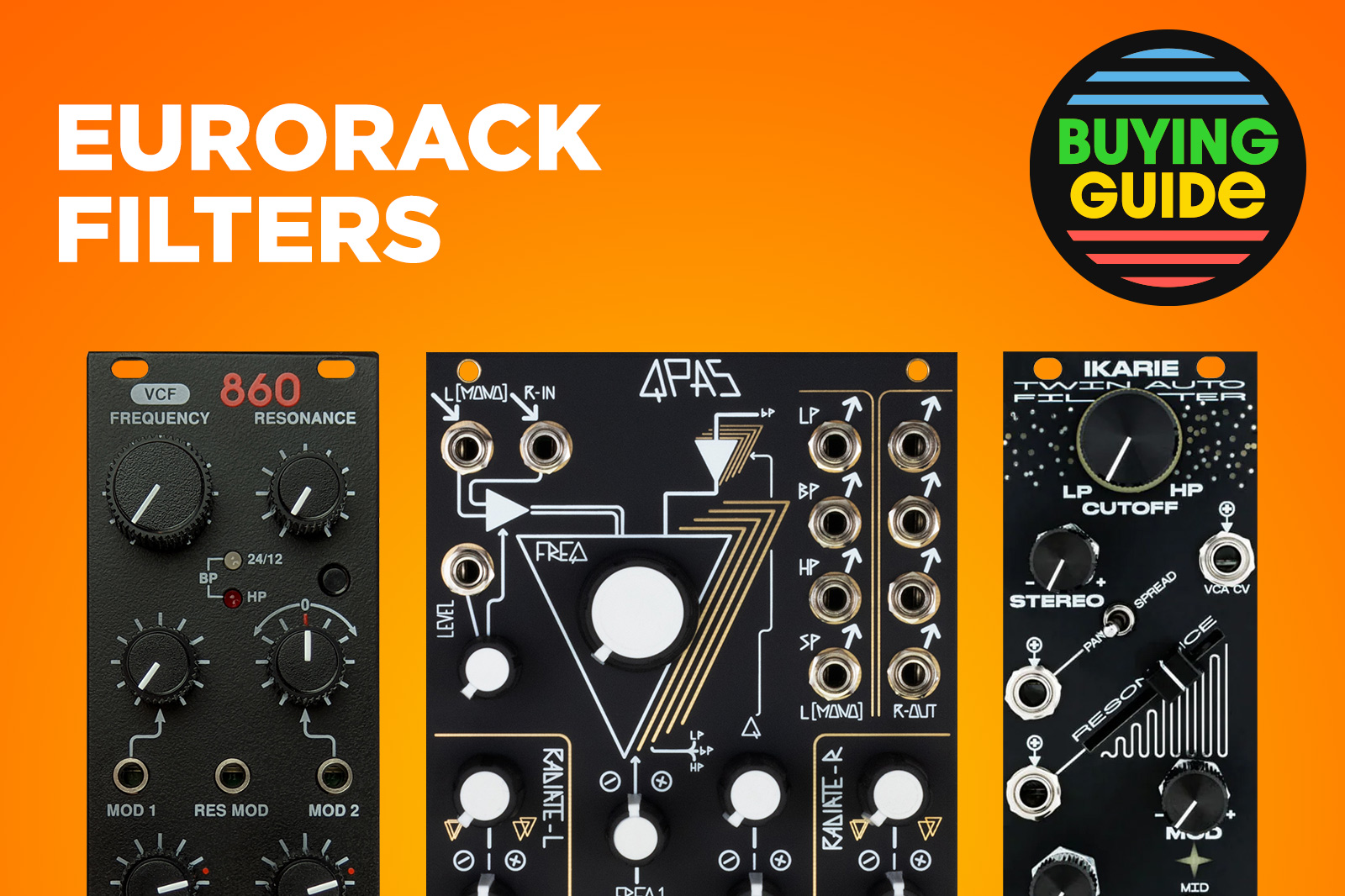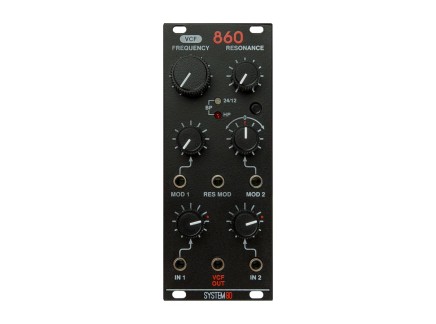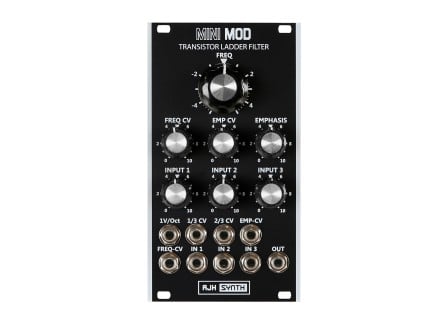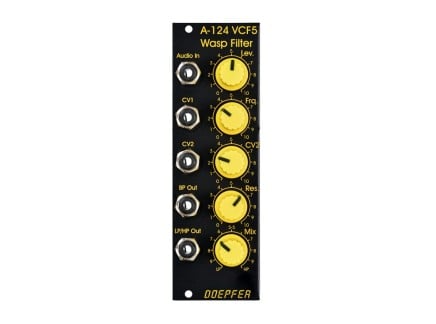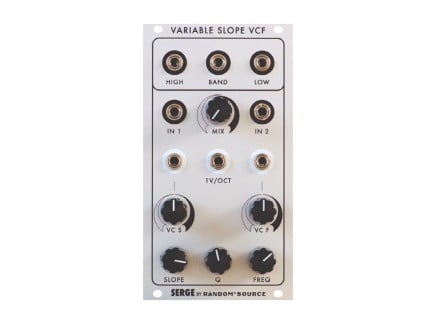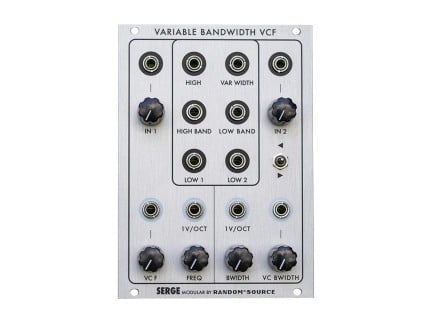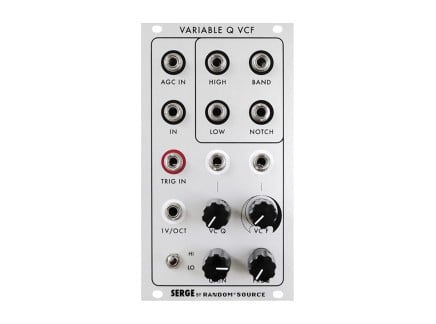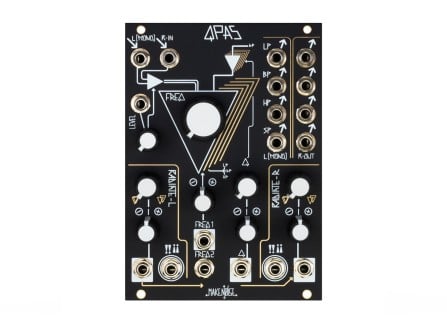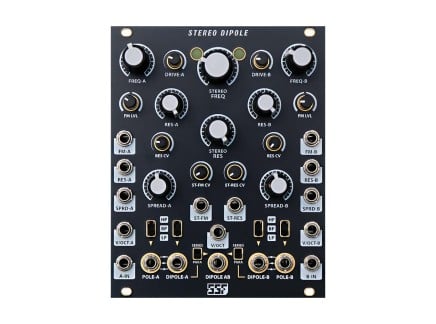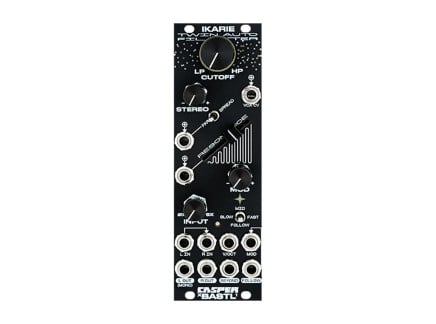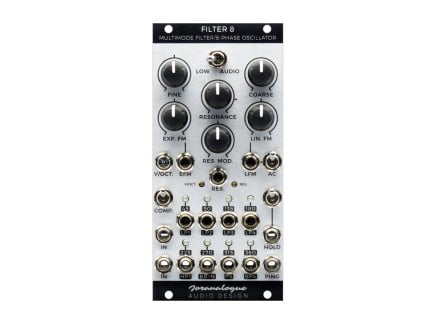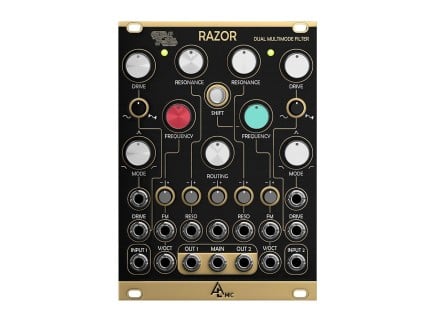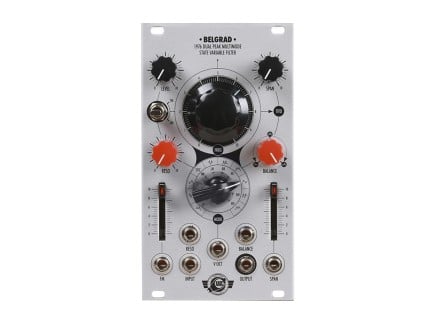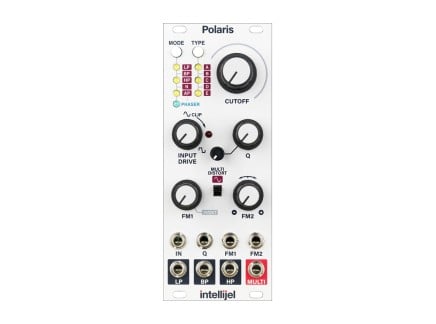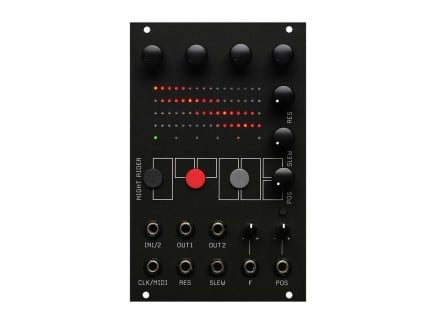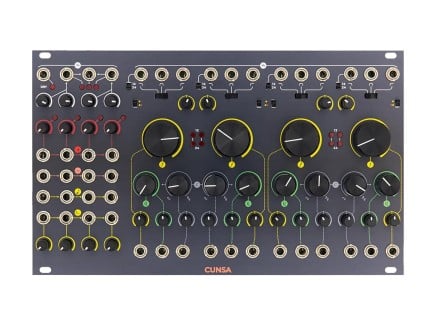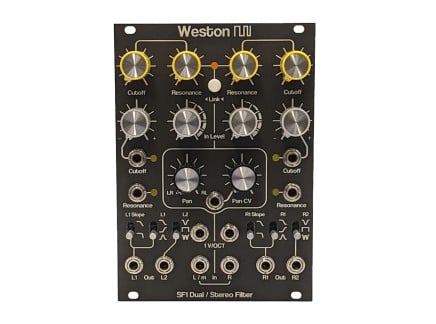For many, filters lie directly at the heart of Eurorack modular synthesis. These sound shaping tools give sonic character to your synth patches. From warm timbres to aggressive tones, they can add a lot to a basic incoming waveform. Unlike the initial days of modular synths, though, filters are no longer confined to simple filter sweeps and throaty resonances.
Those classic functions still have a place in any modular rack—but modern-day Eurorack filters can do a lot more than filter out frequencies of an incoming signal. There are Eurorack filters that can give you binaural spatialization, four-note harmonies in self-oscillation, asymmetrical distortion circuits, and so much more.
We have broken down this buying guide for Eurorack filters into three sections, focusing on classic filters, stereo filters, and new-school filters. We list some of the best filters in each category. Of course, there's a lot out there—so this is not an exhaustive list. But it is a great starting point when looking for the best Eurorack filters in the market.
Classic Analog Filters
System 80 860 mkII
If you are after an analog filter that gives you enough flexibility, consider the 860 MkII. It is the successor to, both, the Jove filter and MkI from System 80. Much like the Jove filter, it is a reinterpretation of the legendary Jupiter-6 filter from the 80s, with a few added features.
The filter has four modes: bandpass, highpass, and two modes for lowpass. You can select between 12db and 24db slopes for the lowpass output. The two inputs have their own gain knobs, which means you can use it as a submixer in your patches. There are unipolar and bipolar cutoff modulation inputs with their own attenuators, and CV input for resonance. Together, these controls allow you enough control over the shape of the filter output.
An added bonus of the Mk2 is that it remembers the last used filter mode between power cycles, which can come in handy when traveling for live shows.
Key Features:
- Reinterpretation of the Roland Jupiter-6 filter
- Four modes selectable with a switch
- Filter mode recall
- Two inputs with dedicated gain knobs
- Unipolar and bipolar cutoff modulation
- CV input for resonance
- Great for: Classic filter sweeps, Jupiter-6 like filter tones
AJH Minimod VCF
If you are after the classic Moog ladder filter sound, the AJH Minimod VCF is a no-brainer. The filter module is built on the circuit of the legendary Model D synthesizer from Moog. The underlying circuitry of this VCF is the same as that of the original, which means you get the trusted 24db/oct slope. But there are some added features. There are 3 inputs, for instance, which can accept external signals up to 16V before clipping. That means you can use the AJH Minimod VCF as a handy submixer in your rack.
Additionally, unlike the original, there are four CV inputs for modulating the cutoff frequency. There is a variable CV input, a 1V/oct input, and 1/3 and 2/3 inputs. The latter replicate the keyboard tracking switches of the original Minimoog Model D.
There is CV control for resonance (Emphasis) with its own attenuator, so you get plenty of room to shape the filter response. This lowpass filter can also go into overdrive territory, thanks to a jumper at the back.
Key Features:
- 24dB/oct slope
- Three inputs for external signals
- Four CV controls for cutoff frequency
- Self-oscillates at high resonance values
- CV control for resonance with a dedicated attenuator
- Overdrive jumper at the back
- Great for: Fat Moog-style filter tones, typical of transistor ladder filters
Doepfer A-124 Wasp Filter
Doepfer is known for its workhorse Eurorack modules and the A-124 VCF5 Wasp Filter is no different. It is a 12dB multimode filter that is inspired from the circuity of the EDP Wasp synthesizer from the 1970s (hence, the name). The circuitry abuses the characteristics of digital inverters, which gives the filter its recognizable “dirty” sound.
You can modulate the cutoff frequency with two separate CV inputs. One of them has its own attenuator. There is a bandpass output and a combined out for highpass and lowpass filtering. The related knob decides the output between lowpass and highpass. In the middle, it gives you notch filtering. On the left and the right, you get varying mixes between lowpass and highpass filtering.
Unlike most filters in the A-100 system, though, this does not self-oscillate. But there is manual control for resonance for shaping the sound. Note—the A-124 is available in both classic silver and black/yellow color schemes.
Key Features:
- 12dB/oct slope
- Wasp filter circuitry
- “Dirty” filter sound
- Two CV inputs for cutoff frequency modulation
- Bandpass output
- Combined output for highpass and lowpass with a Mix knob
- Great for: Waspy filter tones, and notch filtering effects
Random*Source Serge VCFQ/VCFS/VCF2
If you are after vintage filters of the 70s, Random*Source has officially licensed and Serge’s classic analog filter designs—the Variable Q Filter (VCFQ), the Variable Slope Filter (VCFS), and the Variable Bandwidth Filter (VCF2).
Random*Source Serge VCFQ

The Random*Source VCFQ is a faithful recreation of the Serge VCFQ. It is a multimode filter with 12dB/oct slope, variable input gain, and 1V/oct tracking. There are four simultaneous outputs—highpass, lowpass, bandpass, and notch. Frequency and resonance have manual as well as CV controls. Don’t get fooled by its simple UI, though. Even with those seemingly basic filtering functions, the VCFQ can do a lot.
For example, the trigger input can detect rising-edge pulses and give you round analog percussion (think of this like "pinging" a filter). In “lo” mode, the filter acts as an LFO, and the trigger input can be used to create rhythmically-accentuated modulations. In low-frequency mode, the VCFQ can even act as a slew limiter when excited with LFOs or a Sample and Hold.
VCFQ won't self-oscillate on its own—but if you patch the bandpass output back into the audio input, you'll get crystal-clear oscillations for days.
Key Features:
- Four simultaneous outputs
- 12dB/oct slope
- “Lo” mode for LFO-like behavior
- Can function as a slew limiter in "lo" mode
- Great for: Vintage filter tones, classic filter sweeps, and thick percussive filter pings
Random*Source Serge VCFS
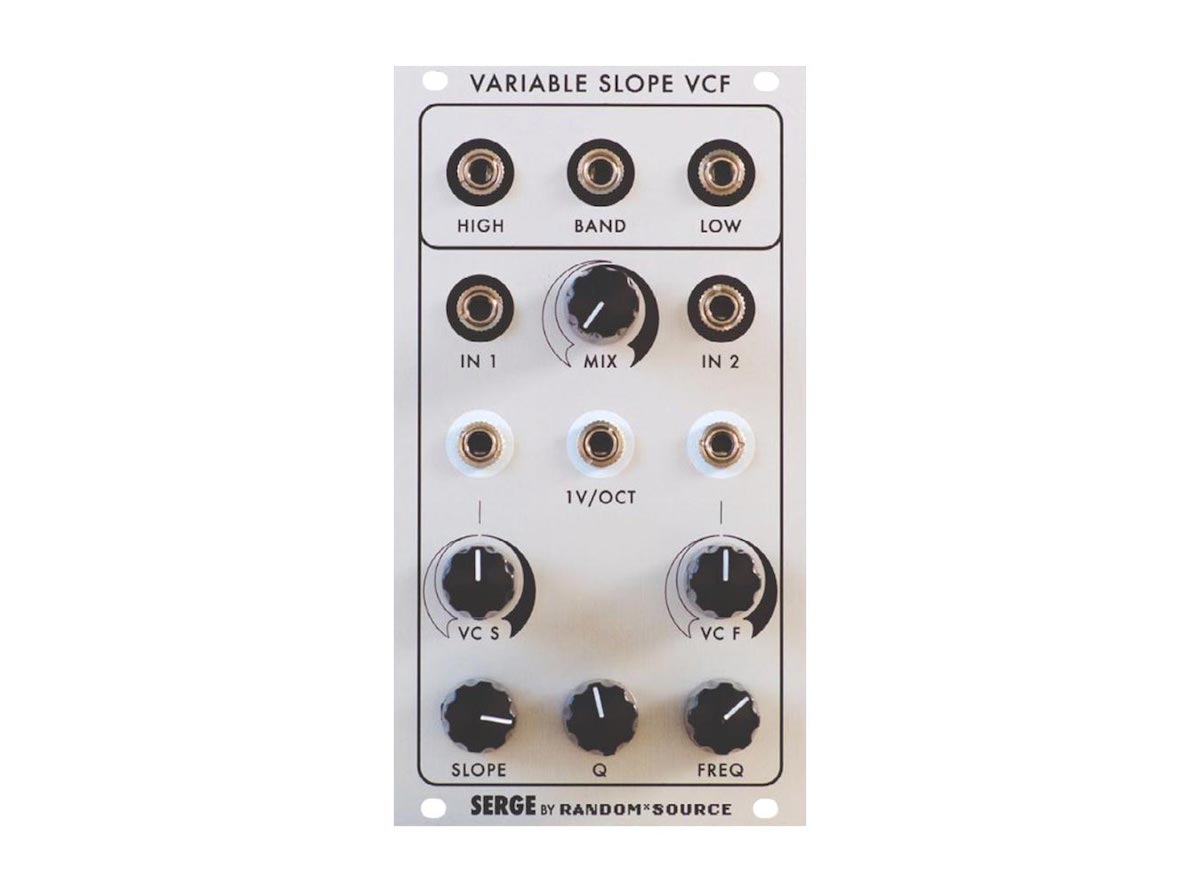
Much like the Variable Q Filter, the Variable Slope Filter has the distinct vintage character of the Serge circuitry. There are highpass, lowpass, and bandpass outputs, 1V/oct tracking, and two controls for shaping the resonant behavior. Increase the slope for steep frequency rolloffs and fine-tune the resonance with the dedicated Q control. There are two inputs with a crossfader in the middle, which allows you to use the filter as a submixer, too.
Key Features:
- Three simultaneous outputs
- Two inputs with crossfade
- Variable slope
- Resonance control
- 1V/oct tracking
- Great for: Vintage filter tones, classic filter sweeps, and warm resonant tones
Random*Source Serge VCF2
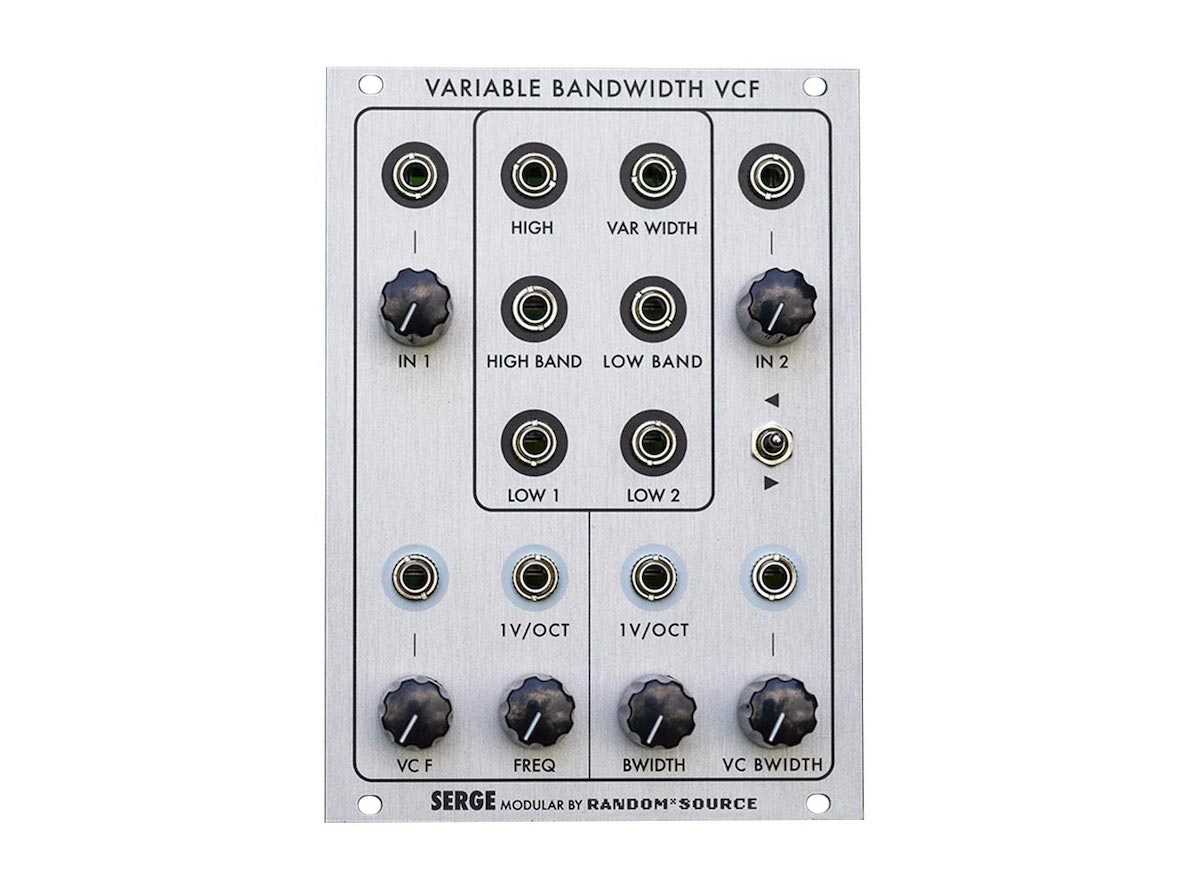
Unlike the VCFQ and the VCFS, Serge’s VCF2 design has two filter cores joined in series. You get six simultaneous outputs—two lowpass, highpass, two bandpass outs, and a variable bandwidth output. There are CV controls for bandwidth and frequency, and two 1V/oct inputs, which can be useful for creating interesting melodic sequences. A handy switch lets you route incoming CV signals to the right or left filter, or modulate both filters simultaneously.
The VCF2 has a relatively flat response, though, which means you don’t get resonant coloration. That said, variable bandwidth filters are fairly uncommon—and the dry, swishing sound of this filter will certainly add something new and unique to your tone-shaping capabilities.
Key Features:
- Variable bandwidth
- Two inputs
- Six simultaneous outputs
- CV controls for frequency and bandwidth
- Two 1V/oct inputs
- Switch for routing cv to right, left, or both sides
- Flat response, which means no resonant coloration
- Great for: Vintage filter tones, rhythmic filtering, fine-tuned spectral alterations, combining multiple filter responses
Stereo Filters
Make Noise QPAS
Trust Make Noise to come up with something truly unique, weird, and versatile. QPAS, which is short for Quad Peak Animation System, is a stereo filter module with four filters. At its heart, it is a stereo imaging and animation module (as the name implies), unlike most other filters on the market, which are mostly concerned with more uniformly shaping the incoming signal.
The four filters share a common cutoff frequency knob and a resonance control. There is a stereo input, which is normalled to the left channel. Thus, you can give it a mono or a stereo signal. There are stereo pairs (normalled to the left channel) for low pass, high pass, bandpass, and what Make Noise calls “smile pass” outputs. The smile pass circuit is not unlike like a notch filter, which is perfect for giving subtle dynamic movement to the incoming signal. It is ideal for drones where you might want to give a hint of movement without having an obvious filter on it.
The Radiate control is where QPAS stands out as a Eurorack filter. It controls the distance of the filter peaks from the main cutoff frequency. The four filter peaks are distributed as two pairs, one each on the left and right channel. As you increase the Radiate control, the pair of peaks travel further apart from the main frequency and from each other. Thus, you get dynamic stereo imaging. Play around with it for subtle stereo width or pronounced binaural effects.
QPAS has plenty of resonance to play around with. However, like many filters that use 12db/oct filtering, there is no self-oscillation. Likewise, it isn’t designed for precise 1V/oct tracking. However, it is still pingable. You can ping the filter input with clocks or envelopes for percussive sounds. In that case, the resonance acts like a decay control for the ping.
There is also the mysterious !! input. Make Noise hasn’t given it a name, much less put out any literature on it—but suffice it to say that the !! inputs significantly alter the sound in a generally desctructive, chaotic fashion. Supply it with clocks or gates to accent the incoming signal. You could also experiment with audio rate inputs for some experimental patching. !! input really shines when you are using QPAS for percussive patching.
There are two CV controls for the cutoff knob, CV control for VCA, resonance, and the two Radiate controls.
Key Features:
- Stereo input
- Stereo outputs for low pass, high pass, bandpass, and smile pass modes
- Four filter cores
- Common cutoff frequency knob
- Common resonance control
- CV control for VCA
- !! input for adding accents to incoming signal
- Radiate control for spreading the outputs of the filters in the stereo image
- Pingable for percussive sounds
- Great for: Percussive filter patches and wide, dynamic stereo imaging from mono sources, West coast style patches
SSF Stereo Dipole
Continuing with the theme of complex filters that can do a lot more than simple filtering, there is SSF’s Stereo Dipole filter module. Like Make Noise QPAS, it has four filter cores, distributed as pairs on left and right channels. The two channels are identical with independent frequency and resonance control, spread, and dipole output that corresponds to the main VCF. The spread knob moves the secondary filter away from the main frequency, much like Make Noise QPAS.
Unlike the QPAS, though, there is v/oct tracking (and plenty of it). The two channels have pitch tracking for the main VCF. There is a common v/oct input for the two filter sections, which can give you some really interesting melodic sequences. You can also supply pitch information to the Spread CV for some bizarre melodic disruption.
And that’s just the beginning of the Stereo Dipole filter. You can choose between Highpass, Lowpass, and Bandpass outputs for the main VCF as well as the related dipole output. You can chain the two filter peaks in each section in series or in parallel. Together with the filter modes, this allows for a lot of permutations and combinations, and a very varied sonic palette. You can even create 4-note harmonies with this filter by playing around with the main VCF and Spread of each section, and then moving the cumulative frequency knob in the center.
The Dipole AB output is the mono sum of all four filters. There is Drive to add subtle harmonics to the output or waveshape at extreme values. There is self-oscillation at high resonance values, of course, which means you can use it as an oscillator, or even an LFO when you have the VCF and Spread at low values. In fact, you can use one section as an LFO and modulate the other section with it for some self-patching experiments.
From resonant tones to percussive, clicky rhythms, the SSF Stereo Dipole is a beast. However, fair warning: you can do so much with it that basic filtering might be the last thing you would want to use it for.
Key Features:
- Four filter peaks
- Two identical filter sections
- CV controls for everything
- Multimode with several possible combinations between the four filters
- Cumulative outputs for the two sections
- Accurate v/oct tracking
- Stereo frequency and stereo resonance outputs
- Dipole AB output, which is the mono sum of all four filters
- Great for: Binaural imaging, percussive filter rhythms, resonant tones, experimental melodic filter patching
Bastl Instruments Ikarie
Ikarie is a state-variable stereo filter from the Bastl stable. Unlike most other state-variable filters, though, Ikarie morphs between lowpass and highpass outputs instead of giving you discrete outputs. Depending on your patch, you can also get bandpass or notch filtering effects from this module. Essentially, Bastl Ikarie has two filter cores with 12db/oct slope. You can use the parallel filter cores for stereo imaging effects, or you can also chain them to get one filter with 24db/oct slope.
The Beyond output is where Bastl Ikarie really shines. It gives you the spectral difference between the two filters, which allows you to turn the module into a twin-peak filter (a la Rob Hordijk). There is v/oct tracking, a VCA with CV input, and CV controls for resonance and panning. Bastl Ikarie also has a neat envelope follower with three settings. You can use it to get more complex waveshapes for modulating your signals.
In terms of the sonic character, you can get a lot out of this compact module. Expect throaty resonances typical of twin-peak filtering when playing around with Beyond, detuned filter effects with Spread CV, and glassy resonant pings when exciting the filter with short envelopes.
Key Features:
- Two filter cores that can be chained together
- Morphing between lowpass and highpass outputs
- Twin peak filtering with Beyond output
- Input gain that can go into distortion territory
- Envelope follower
- 1V/oct tracking
- CV controls for panning and spread
- Great for: Binaural spatialization, percussive filter pings, throaty resonant tones, squelchy, watery textures
New School Filters
Joranalogue Filter 8
What makes the world of modular synthesizers so much fun? You can use modules in atypical ways. For example, you can use filters as percussive instruments or even oscillators. Joranalogue's Filter 8 makes those atypical filter tasks very hands-on and easy.
For example, there is a dedicated ping input for that classic filter pinging sound. And you can get all manner of percussive tones by using any of the 8 different outputs. For example, use one of the lowpass outputs for bassy drums. For toms, pick the bandpass output.
There is self-oscillation, which means you always have a handy sine wave oscillator at your disposal. When self-oscillating, switch to “low” mode to get an LFO. There are exponential and linear FM inputs for chaotic FM tones. And there is a Hold function for temporarily freezing modulations. Try patching a Sample and Hold signal into the “Hold” function for generative patching.
With 8 different outputs, including 4 different varieties of lowpass filtering, the filter offers a lot of self-patching possibilities. Of course, it works as a classic audio filter, too, with its OTA-style circuity. The Joranalogue Filter 8 treads the middle path between classic filter functions and new-age modular wizardry.
Key Features:
- OTA-style analog filter
- 8 different filter modes, including 4 lowpass modes
- Can function as a sine wave oscillator with accurate pitch tracking
- Linear and exponential FM inputs for metallic FM tones
- Two external signal inputs
- Hold function for freezing modulations
- Dedicated ping input for filter pinging sounds
- Switch between audio rate and low frequency oscillation at high resonance values
- Plenty of self-patching possibilities
- Great for: Percussive filter tones with different timbres, self-patching and feedback loops, clean audio filtering
After Later Audio Razor
A clone of the now-discontinued Mutable Instruments Blades, After Later Audio Razor is a dual multimode filter with a ton of capabilities. There are two identical filter sections, each with a 12dB/oct slope. The Mode knobs allow you to morph between low pass, high pass, and bandpass filtering. There is Drive for adding subtle harmonics. But you can crank it for aggressive tones, thanks to the filter’s two-stage wavefolding
The shift control in the center links the two filter sections. There is self-oscillation with stable pitch tracking, which means you can use the two filters as oscillators. Since you have two identical filter sections, you can have one section that is self-oscillating and patch it into the second section for some rich FM tones. The Routing control in the middle changes how the two filters are chained—in series or in parallel. Much like the Mode control, the Routing control also morphs between different filter chaining, giving you more dynamic patches.
Mutable Instruments might have stopped production, but you can still get your hands on its versatile multimode filter, thanks to this exact functional replica.
Key Features:
- Dual multimode filter
- Two identical filter sections
- Morphing between lowpass, bandpass, and highpass filter modes
- Morphing between filter chaining - series or parallel
- Stable v/oct tracking when self-oscillating
- Drive for harmonics and two-stage wavefolding circuit
- Self-patching possibilities
- Great for: Percussive filter pings, dynamic filter tones with the help of morphing between three different filter modes, self-patching and feedback loops, aggressive textures
Xaoc Devices Belgrad
Some filters can do so much more than subtractive synthesis—and Xaoc Devices Belgrad is among them. It is a dual core, state variable filter, and you can choose between 10 different modes with a handy knob in the center. Gain and resonance change between the different modes, so you might want to ride your levels during a live performance.
The main frequency knob sets the frequency for both filter cores. The Span knob changes the distance between the two filter peaks and the distance of the peaks from the central frequency. The Span knob has a non-linear response. Play around with it for filter detune effects and vocal formants.
Unlike most filters, there is more than one way to shape the resonance. There is the main resonance control and a Balance control that decides which of the filter peaks is emphasized more. But where the Belgrad really becomes interesting is in self-oscillation.
Turn the resonance high enough for the filter to self-oscillate. Then play around with Balance and Span controls to get interesting sonic results. As you keep turning the resonance higher, you start to introduce saturation in the feedback circuit for more aggressive tones.
There is also the Tito switch, which applies audio rate modulation to the filters. You can choose between self-modulation for aggressive textures or cross-modulation for chirpy tones. Keep the Tito switch in the middle position to bypass audio rate modulation.
An input gain that goes into overdrive territory and enough CV controls for the various parameters make it a really flexible filter in Eurorack.
Key Features:
- Dual core filter
- 10 filter modes for a wide range of sonic possibilities
- Span control for detuning the filter cores
- Additional Balance control for shaping the resonance
- Audio-rate self modulation switch for aggressive or experimental tones
- Self-oscillating filter at high resonance values
- FM and v/oct inputs for the main cutoff frequency
- Great for: Saturated tones, chirpy and warbly textures, vocal formant results, classic subtractive synthesis
Intellijel Polaris
With a possible 27 filter modes and a phaser circuit at your disposal, Intellijel's Polaris is, arguably, one of the most versatile filters in Eurorack format. An OTA-style filter, Polaris has three simultaneous outputs for highpass, lowpass, and bandpass filtering. The Multi output gives you access to 27 different filter modes, including an AP phaser mode. Combine this mode with frequency modulation to achieve phaser effects.
For frequency modulation, too, there are two inputs, which increases the dynamic possibilities in filtering. Other than the phasing effects, where Polaris really shines is its asymmetric distortion circuit. Crank up the input drive to get some really aggressive, tasty tones. Even with the drive turned down, you get thick, creamy filtering.
Key Features:
- OTA-style filter
- 27 filter modes, including AP phaser mode for phasing effects
- Three simultaneous outputs for bandpass, lowpass, and highpass
- Asymmetrical distortion circuit
- Input drive for aggressive tones
- Two frequency modulation CV inputs
- Great for: Straightforward subtractive synthesis with thick tones, saturated textures, phasing effects
Our Takeaways
Just like with all other module choices, the filter(s) that you pick depends on what you want to achieve in your modular rack. For live performances where you want more control over the output, pick one of the classic filters. If you are going for more generative stuff, either in the studio or on the stage, filters like Make Noise QPAS and Xaoc Devices Belgrad are a good bet.
Your preferred patching style can also be a governing factor when picking a filter for your rack. For example, if self-patching and feedback loops are more your style, Joranalogue Filter8 is a great choice. For classic subtractive synthesis with a distinct character, pick a Doepfer wasp filter.
There are a lot of choices out there. And each one is great at what it does. It depends on your budget, the space in your rack, the tones and textures you are after, and the amount of functionality you want in your filter.

